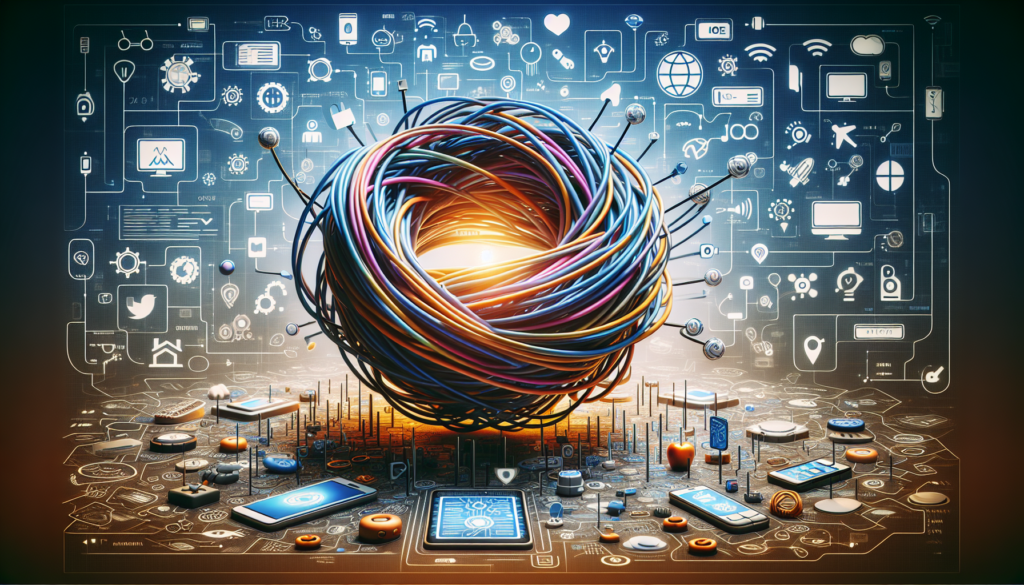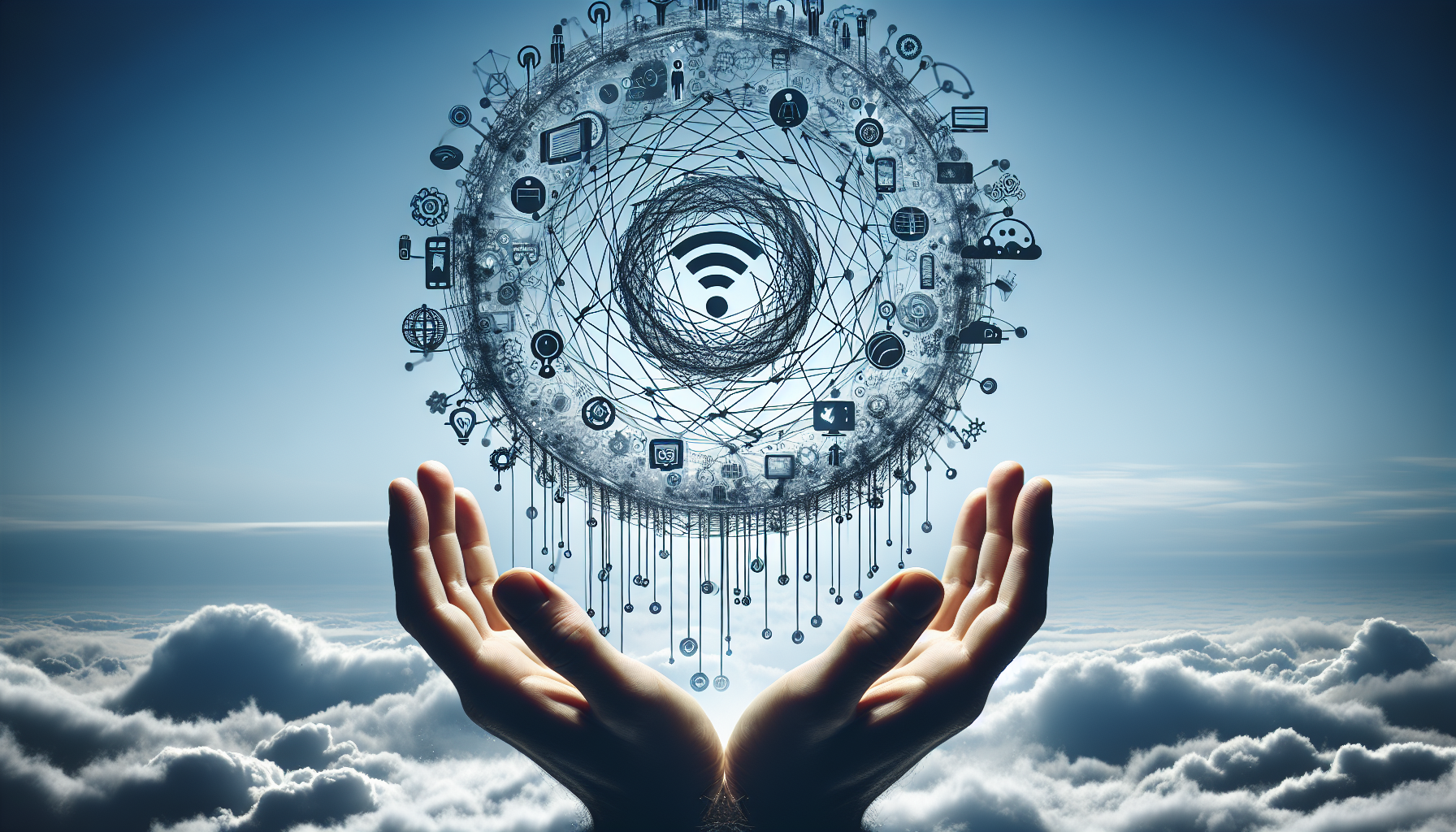IoE, or the Internet of Everything, is a term that permeates our fast-paced digital world. It refers to the vast network of connected devices, systems, and people that work seamlessly together, sharing data and information to enhance our daily lives. From smart homes to intelligent transportation systems, IoE has the potential to revolutionize the way we live, work, and interact. But what exactly does IoE mean? Let’s uncover the meaning behind this buzzworthy acronym.

What Does IoE Mean?
Definition of IoE
IoE, also known as the Internet of Everything, is a concept that describes the integration of people, processes, data, and things through the power of the internet. It goes beyond the traditional idea of the Internet of Things (IoT) by not only connecting physical devices but also connecting people, data, and processes. In simple terms, IoE is all about connecting everything and everyone in a meaningful and intelligent way, creating a network of interconnected devices, people, and systems that work together to improve efficiency, productivity, and value.
Key Components of IoE
Internet of Things (IoT)
The Internet of Things (IoT) is a fundamental component of IoE. It involves connecting physical objects to the internet so that they can be monitored, controlled, and interacted with remotely. These objects, often embedded with sensors, can collect and share data, enabling real-time monitoring and analysis. IoT devices range from smart home appliances and wearables to industrial equipment and vehicles. By integrating IoT devices into IoE, businesses and individuals can harness the power of data and automation to make more informed decisions and optimize processes.
Internet of People (IoP)
The Internet of People (IoP) is another crucial aspect of IoE. It focuses on connecting individuals and fostering collaboration and communication. Through social media, instant messaging apps, and online platforms, IoP allows people to connect, share information, and work together regardless of their physical location. IoP enables seamless communication and empowers individuals to collaborate on projects, exchange knowledge, and build communities. By connecting people through IoE, information can flow more freely, leading to increased innovation and productivity.
Internet of Data (IoD)
The Internet of Data (IoD) encompasses the large-scale collection, storage, analysis, and sharing of data generated by IoT devices, systems, and applications. IoD enables organizations to derive valuable insights and make data-driven decisions. With the proliferation of IoT devices, the volume and variety of data being generated are staggering. However, IoD aims to transform this deluge of data into meaningful, actionable information. By effectively utilizing IoD within the IoE framework, organizations can unlock unprecedented value, drive innovation, and improve decision-making processes.
Internet of Process (IoPrc)
The Internet of Process (IoPrc) focuses on integrating business processes, workflows, and automation into the IoE framework. It aims to connect and optimize various processes across different systems, devices, and applications. With IoPrc, organizations can streamline operations, reduce manual intervention, and enhance efficiency. By automating repetitive tasks, IoPrc frees up human resources to focus on more strategic and value-added activities. It also enables better collaboration between different departments and systems, leading to improved productivity and customer satisfaction.
Internet of Services (IoS)
The Internet of Services (IoS) refers to the integration and delivery of services through the internet. IoS involves the creation and deployment of cloud-based services that can be accessed remotely. This component of IoE enables the provisioning of various services, such as software-as-a-service (SaaS), platform-as-a-service (PaaS), and infrastructure-as-a-service (IaaS). By utilizing IoS, organizations can leverage scalable and cost-effective solutions without the need for extensive on-premises infrastructure. It allows businesses to focus on their core competencies while relying on specialized service providers for other aspects of their operations.
IoE in Practice
IoE in Smart Cities
One of the most promising applications of IoE is in the development of smart cities. By leveraging the power of interconnected devices and systems, IoE can enhance urban infrastructure, improve resource management, and enhance overall quality of life. Smart cities can leverage IoE to monitor and optimize energy consumption, reduce traffic congestion, enhance public safety, and provide personalized services to residents. For example, by implementing smart grid technologies and connected sensors, energy distribution can be optimized, resulting in lower costs and reduced environmental impact. Additionally, smart transportation systems can use real-time data to optimize traffic flow and reduce commute times.
IoE in Healthcare
IoE has the potential to revolutionize the healthcare industry. By connecting medical devices, patient monitoring systems, electronic health records, and healthcare professionals, IoE can enable remote patient monitoring, telemedicine, and personalized healthcare delivery. For example, wearable devices can continuously monitor vital signs and alert healthcare providers in case of emergencies. IoE also enables more accurate diagnosis and treatment through the aggregation and analysis of large-scale health data. Additionally, healthcare providers can leverage IoE to streamline administrative processes, improve patient engagement, and enhance the overall efficiency and effectiveness of healthcare delivery.
IoE in Manufacturing
Manufacturing processes can greatly benefit from IoE. By connecting and integrating various aspects of the manufacturing process, IoE can enable real-time monitoring, predictive maintenance, and enhanced operational efficiency. For instance, by connecting machines, sensors, and production lines, manufacturers can gather data on equipment performance, identify anomalies, and proactively address maintenance needs. IoE can also facilitate the seamless integration of suppliers, partners, and customers into the manufacturing ecosystem, enabling closer collaboration and just-in-time production. Through the use of IoE, manufacturers can improve product quality, reduce downtime, and optimize supply chain management.
IoE in Transportation
The transportation industry stands to gain significant advantages from IoE implementation. By connecting vehicles, roads, and transportation infrastructure, IoE can enable intelligent transportation systems, enhance safety, and optimize logistics. Through real-time connectivity and data exchange, IoE can provide accurate traffic information, enabling drivers to avoid congestion and plan their routes more efficiently. Additionally, connected vehicles can communicate with each other and infrastructure to enhance road safety and prevent accidents. IoE can also enable autonomous and electric vehicles, leading to more sustainable and efficient transportation systems.
IoE in Agriculture
IoE has great potential in transforming the agriculture industry. By connecting farming equipment, crop monitoring systems, and weather sensors, IoE can optimize agricultural processes, increase crop yield, and reduce resource waste. For example, farmers can use connected sensors to monitor soil moisture levels and adjust irrigation schedules accordingly, leading to more efficient water usage. IoE can also enable precision agriculture techniques by utilizing satellite imagery and data analytics to optimize fertilizer and pesticide application. Furthermore, by connecting farmers and markets, IoE can facilitate better supply chain management, reduce food waste, and ensure food security.
Benefits and Challenges of IoE
Benefits of IoE
The adoption of IoE offers numerous benefits across various sectors. One of the key advantages is improved efficiency. By integrating and optimizing processes through IoE, organizations can streamline operations, reduce manual intervention, and enhance productivity. Additionally, IoE enables cost savings through energy optimization, predictive maintenance, and better resource management. It also facilitates more informed decision-making through real-time data analytics and insights. Moreover, IoE has the potential to enhance customer experiences by personalizing services and providing seamless interactions. Lastly, IoE fosters innovation and collaboration by connecting people, devices, and data, leading to new opportunities and disruptive business models.
Challenges of IoE
Despite its potential benefits, IoE implementation poses several challenges. One of the primary concerns is data security and privacy. With the massive volume of data being generated and shared, there is an increased risk of data breaches and unauthorized access. Ensuring robust cybersecurity measures and implementing strong data protection policies are crucial to address these challenges. Additionally, interoperability and standardization issues arise due to the diverse range of devices, platforms, and protocols involved in IoE. Achieving seamless connectivity and compatibility between different systems and devices is a significant challenge. Moreover, scalability is often a challenge, as IoE involves managing and processing vast amounts of data in real-time. Adequate infrastructure and computational resources are required to handle this scale effectively.

IoE and Security Concerns
Cybersecurity Risks in IoE
As IoE expands, so do the cybersecurity risks associated with it. The interconnected nature of IoE creates a broader attack surface for cybercriminals to exploit. Weaknesses in one connected device or system can potentially compromise the entire network. Cybersecurity risks in IoE include unauthorized access to sensitive data, data breaches, identity theft, and malware attacks. It is critical for organizations to implement robust security measures to protect their networks and devices. This includes implementing strong authentication mechanisms, encrypting sensitive data, regularly updating software and firmware, and continuously monitoring for potential threats.
Privacy Concerns in IoE
IoE raises significant privacy concerns, as it involves the collection and analysis of vast amounts of personal data. With the interconnected nature of IoE, there is the potential for data to be shared across multiple devices and platforms. This raises concerns regarding data ownership, consent, and user control over their personal information. Organizations must establish transparent privacy policies and obtain explicit consent from users for data collection and usage. Additionally, there is a need for strong data protection frameworks and regulations to ensure the privacy rights of individuals are respected.
Future of IoE
IoE and Artificial Intelligence
The integration of IoE with Artificial Intelligence (AI) holds immense potential for driving innovation and transforming industries. By combining the real-time data and connectivity of IoE with the analytical abilities of AI, organizations can gain valuable insights and enable autonomous decision-making. AI algorithms can analyze vast amounts of data and identify patterns and anomalies, offering predictive capabilities and actionable recommendations. In the future, we can expect to see AI-powered IoE applications in various domains, such as autonomous vehicles, smart homes, personalized marketing, and advanced healthcare diagnostics.
IoE and 5G
The deployment of 5G networks will be a catalyst for IoE growth and advancement. With its significantly higher bandwidth, lower latency, and higher capacity, 5G enables seamless connectivity and data transmission, supporting the massive scale and real-time requirements of IoE. The combination of 5G and IoE will unlock new opportunities and use cases across various sectors. For instance, autonomous vehicles will benefit from ultra-low latency and reliable connectivity, enabling real-time communication and coordination. Additionally, smart cities can leverage 5G-enabled IoT devices and infrastructure to enhance urban services, such as traffic management, public safety, and energy optimization.
IoE and Edge Computing
Edge computing is another key component that complements IoE. With edge computing, data processing and analysis occur closer to the data source, reducing the reliance on cloud infrastructure and enabling real-time decision-making. By leveraging edge computing, IoE applications can overcome the challenges of latency, privacy, and bandwidth limitations. Edge devices can perform data filtering, analysis, and actuation locally, enhancing the responsiveness and efficiency of IoE systems. Combining IoE and edge computing enables faster and more reliable data processing, minimizes latency, and reduces the reliance on centralized cloud resources.
In conclusion, the Internet of Everything (IoE) is a powerful concept that aims to connect and integrate people, devices, data, and processes through the internet. It encompasses various components such as the Internet of Things (IoT), Internet of People (IoP), Internet of Data (IoD), Internet of Process (IoPrc), and Internet of Services (IoS). IoE has numerous practical applications in areas such as smart cities, healthcare, manufacturing, transportation, and agriculture. While IoE offers significant benefits in terms of efficiency, cost savings, and innovation, it also presents challenges related to security, privacy, interoperability, and scalability. The future of IoE looks promising with the integration of Artificial Intelligence (AI), the deployment of 5G networks, and the adoption of edge computing.
